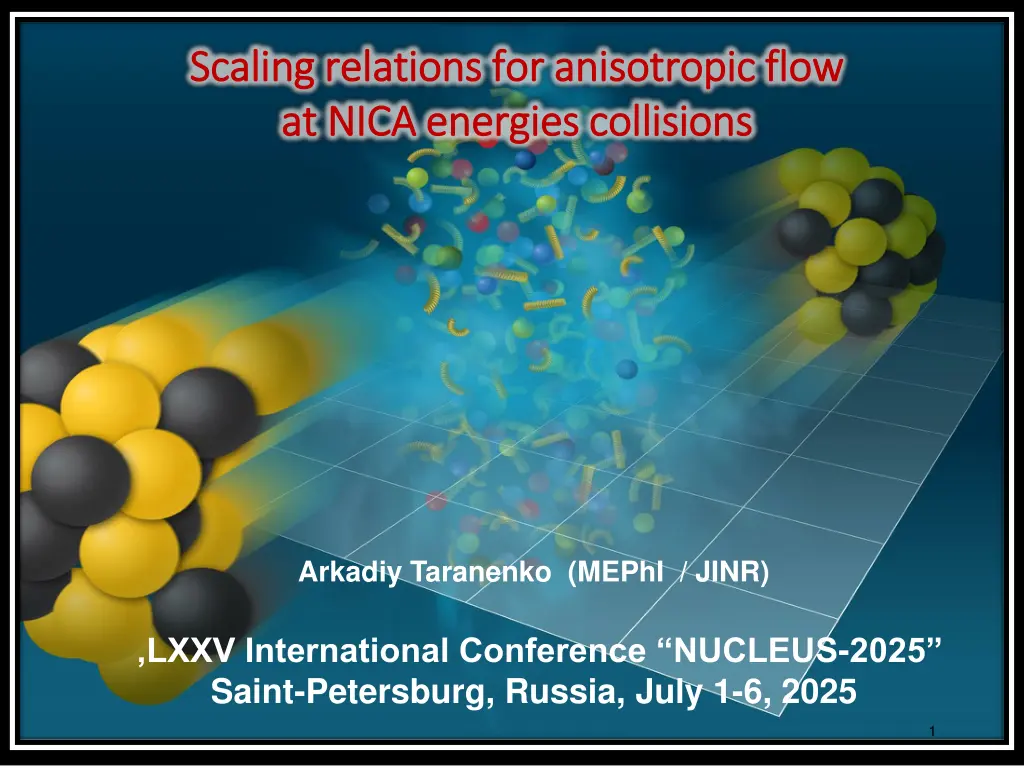
Anisotropic Flow at NICA Energies and Collisions - Nucleus-2025
Explore the scaling relations for anisotropic flow at NICA energies and collisions discussed by Arkadiy Taranenko at the LXXV International Conference NUCLEUS-2025 in Saint-Petersburg, Russia. Learn about the introduction of anisotropic flow, its properties, results from Beam Energy Scans, and the outlook for flow measurements at NICA. Dive into research on anisotropic flow at RHIC and LHC, scaling with integral flow of charged hadrons, beam-energy dependence of v2 and v3, elliptic flow from the STAR BES program, and more.
Download Presentation

Please find below an Image/Link to download the presentation.
The content on the website is provided AS IS for your information and personal use only. It may not be sold, licensed, or shared on other websites without obtaining consent from the author. If you encounter any issues during the download, it is possible that the publisher has removed the file from their server.
You are allowed to download the files provided on this website for personal or commercial use, subject to the condition that they are used lawfully. All files are the property of their respective owners.
The content on the website is provided AS IS for your information and personal use only. It may not be sold, licensed, or shared on other websites without obtaining consent from the author.
E N D
Presentation Transcript
Scaling relations for anisotropic flow Scaling relations for anisotropic flow at NICA energies collisions at NICA energies collisions Arkadiy Taranenko (MEPhI / JINR) ,LXXV International Conference NUCLEUS-2025 Saint-Petersburg, Russia, July 1-6, 2025 1
OUTLINE 1) Anisotropic flow: introduction 1) Flow and sQGP at RHIC/LHC? 2) Scaling properties of anisotropic flow 3) Flow results from Beam Energy Scans 4) Outlook for flow measurements at NICA 2 R. Lacey, SUNY Stony Brook
Anisotropic Flow at RHIC-LHC dN d ( ) 1 2 + cos v n n n = 1 n Gale, Jeon, et al., Phys. Rev. Lett. 110, 012302 3 R. Lacey, SUNY Stony Brook
Scaling with integral flow of charged hadrons 4 R. Lacey, SUNY Stony Brook
Beam-energy dependence of v2and v3 Petr Parfenov for STAR Collaboration, of normalized v2 and v3 for all centralities and beam energies J.Phys.Conf.Ser. 1690 (2020) 1, 012128 J.Phys.Conf.Ser. 1690 (2020) 1, 012128 5 Integrated v2 and v3 decrease with decreasing collision energy R. Lacey, SUNY Stony Brook
Beam-energy dependence of v2and v3 J.Phys.Conf.Ser. 1690 (2020) 1, 012128 of normalized v2 and v3 for all centralities and beam energies J.Phys.Conf.Ser. 1690 (2020) 1, 012128 6 Integrated v2 and v3 decrease with decreasing collision energy Similar shape of pT dependence of normalized v2 and v3 for all centralities and collision energies R. Lacey, SUNY Stony Brook
Anisotropic Flow at RHIC partonic? = mT m n=2 for mesons and n=3 for baryons R. Lacey , A. Taranenko PoS 2006 (2006) 021 7 R. Lacey, SUNY Stony Brook
Elliptic flow from STAR BES program STAR , Phys Rev C93, 14907 (2016) 8 R. Lacey, SUNY Stony Brook
Anisotropic Flow at RHIC BES Li-Ke Liu (CCNU), STAR Collaboration, CPOD 2024 At high energies, data follows NCQ scaling, indicating partonic collectivity??? NCQ scaling for v2 breaks completely at 3.5 GeV and below, 9 R. Lacey, SUNY Stony Brook
NCQ scaling: hybrid models Hybrid models with QGP phase are used for BES energy range ( ???= 7.7 200 GeV), such as vHLLE+UrQMD and AMPT SM NCQ scaling holds for hybrid models well 10
NCQ scaling: cascade models STAR Collaboration, arxiv.org/abs/2007.14005 Scaling holds up at 4.5 GeV in STAR data and pure string/hadronic cascade models (without partonic d.o.f.) ???/?? scaling at 4.5 GeV might be accidental more careful studies should be performed 29.08.2023 LomCon-2023 11
Anisotropic flow in heavy-ion collisions at high baryon density M. Abdallah et al. STAR, Phys. Lett. B 827, 137003 (2022) BM@N CBM MPD Anisotropic flow at NICA energies is a delicate balance between: I. The ability of pressure developed early in the reaction zone (????= The passage time for removal of the shadowing by spectators (?????= ?? ??) ? ??,??= ? 2? ??????) II. 12
Beam Energy Dependence of Elliptic Flow (v2) Strong energy dependence of v2at sNN = 2.4-7 GeV R. Lacey, SUNY Stony Brook 13
Beam Energy Dependence of Elliptic Flow (v2) Li-Ke Liu (CCNU), STAR Collaboration, CPOD 2024 Strong energy dependence of v2at sNN = 2.4-7 GeV R. Lacey, SUNY Stony Brook 14
Scaling relations at SIS scaling with passage time ??????? 2??0 ?? ??0= ?0?????? 2? ?????= ?????? Nucl. Phys A 876 (2012) 1-60 The rather good scaling observed suggests that ?? does not change significantly over beam energy range ????= 0.4 2 AGeV ( ???= 2 2.7 GeV) Scaling breaks at ????= 2.9 AGeV ( ???= 3 GeV) 15
STAR published results for protons : Scaling breaks at sNN=3GeV but holds at forward rapidity? 16
Scaling with integral flow: protons in Au+Au at ??? = 2.4 GeV The radial flow is not so srong at low energies 17 R. Lacey, SUNY Stony Brook
Anisotropic flow at Nuclotron / NICA: 2.5-3.0 GeV BM@N agrees with STAR Need new measurements to fill the gap in energy
Summary and outlook NCQ scaling: Holds up for energies ???> 4 GeV in both experimental data and models (hybrid and pure string/hadronic cascade models) Scaling at ???= 4.5 GeV in the experimental data and pure string/hadronic cascade models can be accidental more thorough study should be performed Scaling with passage time: Holds up for energies ???= 2 2.7 GeV and breaks at ??? 3 GeV Shows that at this energy range ?2 passage time ????? of the spectators Scaling relations provide a useful tool to perform comparison between results from different experiments with different system size and beam energies to constrain existing models ??? changes due to the change of the 19






















